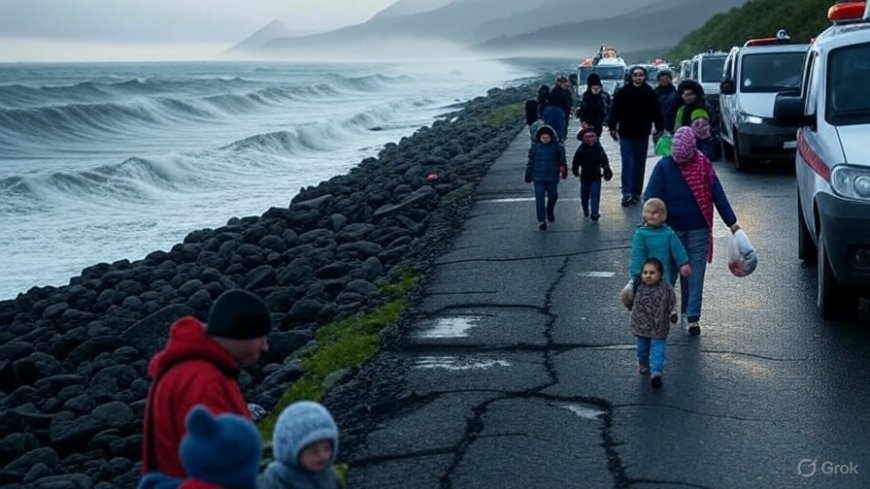BREAKING: Powerful 8.7 Magnitude Earthquake Strikes Off Russia's Kamchatka Coast — Tsunami Waves Recorded, Evacuations Ordered
A massive 8.7 magnitude earthquake struck off Russia's Kamchatka coast early Wednesday, triggering tsunami alerts and widespread coastal evacuations across the Pacific. No casualties or major damage reported yet.

Russia's Far East Rattled by Major Earthquake, Tsunami Waves Recorded Across Pacific
July 30, 2025 | Kamchatka, Russia –
A powerful 8.7 magnitude earthquake struck offshore near Russia’s Kamchatka Peninsula early Wednesday, setting off tsunami warnings across the Pacific Rim and prompting evacuations in multiple countries. While waves up to 4 meters were observed on Russia’s coast, no casualties or significant infrastructure damage have been reported at this time.
According to the United States Geological Survey (USGS), the quake occurred at approximately 4:12 AM local time, centered in the Sea of Okhotsk, about 90 kilometers east of Petropavlovsk-Kamchatsky, a city in Russia’s Far East. The earthquake originated at a depth of approximately 33 kilometers, consistent with megathrust activity common to subduction zones.
Tsunami Alerts Issued Across the Pacific
The Pacific Tsunami Warning Center (PTWC) quickly issued alerts following the quake. Countries across the Pacific basin—including Japan, the United States (Alaska and Hawaii), the Philippines, Papua New Guinea, and New Zealand—were placed on alert or advisory for potential tsunami activity.
In Russia’s Kamchatka Peninsula, waves reaching up to 4 meters were reported in Ust-Kamchatsk and Severo-Kurilsk, prompting swift evacuations of thousands of coastal residents to higher ground. Video footage from Severo-Kurilsk shows sea water surging inland, although no fatalities or property loss have been confirmed.
The Japan Meteorological Agency reported tsunami waves of up to 30 centimeters in parts of Hokkaido, Japan’s northern island, but confirmed that no damage had occurred. Tsunami alerts in Japan and the U.S. were later downgraded or canceled entirely.
Emergency Response and Precautionary Measures
The Russian Ministry of Emergency Situations (EMERCOM) initiated emergency protocols immediately after the quake, dispatching disaster assessment teams to monitor the Kamchatka coastline. Sirens were sounded in coastal towns, and residents were moved to temporary shelters in inland schools and sports halls.
Russian President Vladimir Putin was briefed on the quake and tsunami warning. According to the Kremlin press office, “All emergency services are on high alert. There is no immediate threat to major population centers, but monitoring will continue.”
No casualties or critical infrastructure failures have been reported by Russian authorities as of this writing.
Why This Quake Was So Powerful Yet Relatively Safe
Despite the magnitude, experts say the offshore location and depth of the earthquake helped minimize its destructive potential.
Dr. Natalia Rozhkova, a geophysicist at the Russian Academy of Sciences, stated:
“The quake’s epicenter was far offshore, and while it was a high-energy event, the depth of the rupture and the lack of proximity to densely populated zones likely prevented a large-scale disaster.”
International Reactions and Monitoring
Governments across the Pacific quickly activated national alert systems:
-
Japan’s Meteorological Agency tracked wave activity and issued localized warnings, later canceling them after observing low wave impact.
-
U.S. National Weather Service and NOAA placed Alaska and Hawaii under tsunami advisory status temporarily.
-
New Zealand’s National Emergency Management Agency (NEMA) asked citizens to avoid beaches and harbors as a precaution.
-
The United Nations Office for the Coordination of Humanitarian Affairs (UNOCHA) confirmed that no international emergency assistance has been requested yet, but they remain on standby.
Public Response and Global Monitoring
While no damage has been confirmed, coastal residents in Kamchatka reported scenes of tension and confusion during the early hours.
“People grabbed whatever they could—coats, phones, kids—and ran uphill,” said a local official in Ust-Kamchatsk. “The sirens helped, but many were still in shock from the tremors.”
Seismologists across Asia and North America are continuing to monitor aftershock activity. So far, no significant aftershocks above magnitude 5.5 have been recorded.
Summary of Current Facts (as of 2:00 PM UTC, July 30, 2025):
-
Earthquake Magnitude: 8.7
-
Location: Sea of Okhotsk, 90 km off Kamchatka, Russia
-
Time: 4:12 AM local time
-
Depth: 33 km
-
Casualties: None confirmed
-
Damage: No major structural damage reported
-
Tsunami Waves: Up to 4 meters in Kamchatka, minor waves across Japan and Alaska
-
Evacuations: Thousands in coastal Russia relocated as precaution
-
Current Threat Level: Decreasing; tsunami alerts downgraded or lifted in most regions
Verified Sources Referenced:
By Ronald Kapper
Senior Correspondent, Newssutra.com




















































